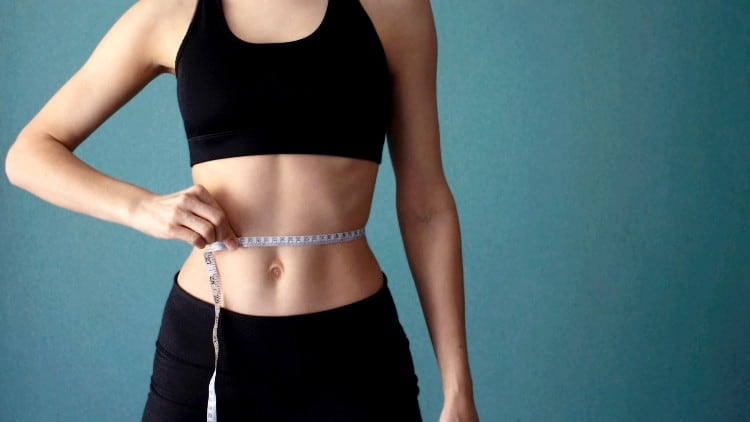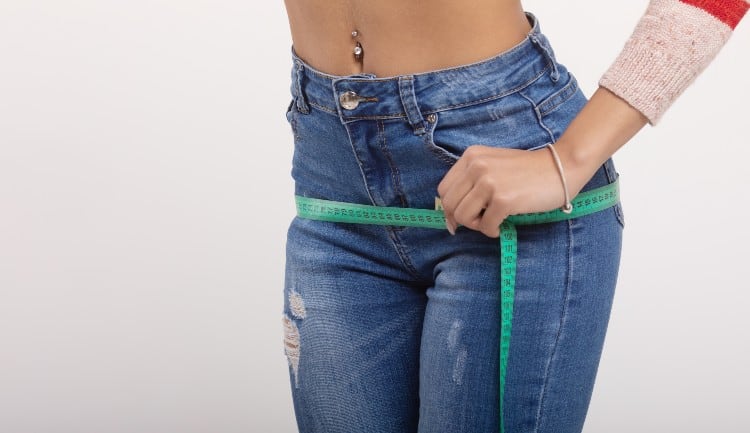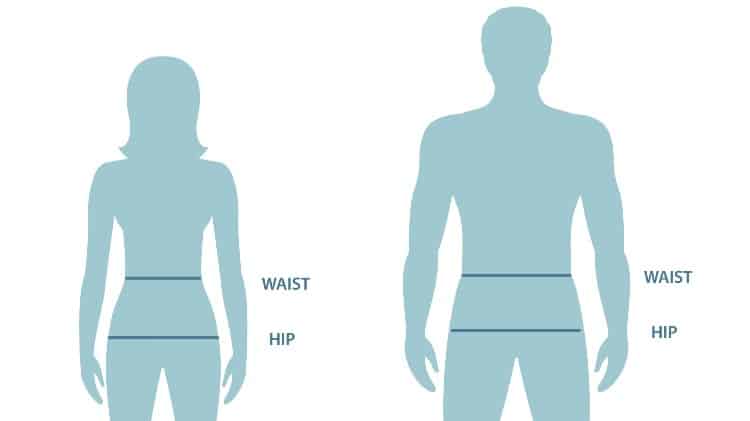Whether you want to shop online or sew your own clothes, you need to master your own measurements to end up with clothing that fits you. Sometimes this gets confusing. For example, when you compare waist vs hip measurements, what is the difference?
A hip measurement describes the circumference around the widest point of the pelvic, or hip, bones. A waist measurement measures the circumference of the waistline or the narrowest point between the ribs and the hips. Both measurements help with selecting fitted pants, dresses, or skirts.
In this article, you will learn how to take waist and hip measurements. You will learn about the importance of the waist-to-hip ratio. Finally, you will discover tips on the best clothes to wear that complement your waist-to-hip ratio.

Quick Navigation
- What is a Waist Measurement?
- What is a Hip Measurement?
- Waist vs Hip: What is the Difference?
- What is a Waist-Hip Ratio?
- What is the Average Difference Between Waist and Hip?
- Should Hips or Waist Be Bigger?
- Why is My Waist the Same Size as My Hips?
- What is an Ideal Waist Size for a Woman?
- How to dress for Your Waist-to-Hip Ratio
- Conclusion
What is a Waist Measurement?
A waist measurement provides the distance around the waistline, or the point of your body right between the bottom of your ribs and the top of your hip bones. This may sound a bit ambiguous, and it’s true that not every body type has a super clearly defined waistline! In that case, you can also use the area just above your navel as a starting point for this measurement.

To take an accurate waist measurement:
- Find a private spot with a mirror and take off your shirt. You will want to take this measurement on bare skin for the best results.
- Stand with your feet slightly apart and flat on the floor. Try to hold yourself with a normal posture and breathe deeply.
- Using a flexible cloth tape measure, start at the narrowest point of your torso or just above your navel. Wrap the measure around your waistline. Make sure the tape measure stays parallel to the floor all the way around you–using the mirror to see your back can help with this.
- Pinch the measure together where the two ends meet after wrapping around your body.
- Note down the measurement you took.
What is a Hip Measurement?

A hip measurement provides an accurate description of the distance around the widest point of your hip bones. This measurement is key to getting pants, jeans, and dresses that fit you well because everyone has a different body type, and wider or narrower hips will not necessarily fit the same clothing styles.
Finding a starting point to take this measurement is pretty easy. Simply locate the top curve of your pelvic bone at your hip. The hip measurement will circle the widest point of your hips.
To take an accurate hip measurement:
- Find a private space with a full-length mirror. While you can pretty easily wrap a tape measure around your hips by yourself, the mirror is necessary to help you keep the tape parallel to the floor to get an accurate measurement.
- Take off your outer clothes, though it is ok to keep underclothing on for this measurement.
- Stand with your feet placed close together, using good posture and relaxed shoulders. Moving your feet will change the position of your hips since your feet and legs are all attached to each other!
- Circle the tape measure around the widest point of your hips. This will include your seat. Usually, the best way to find a starting point for this measurement is to use two fingers to locate the top edge of your hip bone. This feels like a curved, sharp point on either side of your torso.
- You can also eyeball your torso and select the widest point to circle with the tape.
- Make sure you keep the tape level all the way around. This can get tricky as you wrap around your behind, but do your best to keep a straight line. Any sagging or dipping in the tape will lead to an inaccurate measurement.
- The point where the two ends of the tape meet will give you accurate hip measurement. Note this down!
Waist vs Hip: What is the Difference?

The big difference between waist and hip measurements is that they describe separate areas of your body. Your waist is located at the narrowest point of your torso, just above your navel. Your hip measurement starts at the widest part of your hips or the top of the pelvic bone and wraps around your seat.
Hip and waist measurements are not at all the same thing. Yes, they both describe key areas on the torso, but they measure different portions of your body.
Another way to think about the difference between these two measurements is that the waist measurement focuses on the smallest part of the torso, and the hip measurement describes the widest part of the torso.
Most clothing manufacturers will provide both a waist and a hip measurement in a sizing chart to help you find clothes that fit your body. You will also need both of these measurements if you want to select a sewing pattern to make your own clothes.
What is a Waist-Hip Ratio?
The waist-hip ratio measures the difference between your waist and hip measurements. To find your ratio, simply divide the waist measurement by the hip measurement.
For example, suppose you took your waist measurement and noted down 35 inches. Your hip measurement was 40 inches. Divide 35 by 40, and you get a ratio of 0.875.
Why does this ratio matter? It can help you gain an accurate understanding of your own body shape because it indicates what part of your body tends to carry the most weight. It can also help you address certain health concerns.
Body types with a wider waist than hip measurement can lead to many health issues. You may also see this body type referred to as an “apple shape.”
Too much abdominal fat, called visceral fat, can lead to health issues such as high cholesterol, heart disease, diabetes, or even cancer. The WHO states that a waist-to-hip ratio of over 0.90 for men or 0.85 for women is considered abdominal obesity.
You will also see the waist-hip ratio referenced when people talk about ideal body types. Some stylists and fashion experts believe particular kinds of bodies, such as an hourglass figure, are more objectively attractive than others.
One other thing to keep in mind is that the waist-hip ratio is not the same as a BMI, or body mass index, ratio. Your BMI compares your weight and your height, while the waist-to-hip ratio measures the difference between the size of your waist and your hips.
Doctors consider your waist-hip ratio much more important in determining your overall health than your BMI! This is because the placement of fat on your body matters more than how much fat you carry. That abdominal fat we all have is pretty dangerous.
Waist-Hip Ratio Calculator
You can easily calculate your waist-to-hip ratio yourself using the formula provided in this section, or you can find a free calculator online to do the math for you.
To calculate the waist-hip ratio yourself:
- Take your waist measurement.
- Take your hip measurement.
- Divide the waist measurement by the hip measurement.
- Write down the answer.
Alternatively, simply plug your measurements into this handy calculator! Make sure you select either cm or inches to match your measurement.
Ideal Waist-to-Hip Ratio
For health purposes, doctors recommend an ideal waist-to-hip ratio of 0.9 or below for women and 1.0 or lower for men. The basic concept of the ratio for health purposes is that having a smaller waist than hip measurement means you do not have as much of the dangerous kind of visceral fat that can lead to medical issues.
If your ratio lands above what doctors consider a safe range, you may suffer from intra-abdominal obesity. In that case, your best bet is to talk to your doctor about taking preventative steps such as exercising or changing your diet.
Waist vs Hip Measurement Female
On average, female anatomy curves wider at the hips than at the waist, which means women typically have a smaller waist-to-hip ratio. This is because you end up dividing a smaller number (the waist measurement) by a significantly larger number (the hip measurement).
In the United States, the current average waist size for women is between 34.5 and 37.5 inches, depending on which study you go by. The average hip size currently rests at 43-44 inches. This means that the average waist-to-height ratio for women falls at either .78 or .88, once again depending on which study you believe.
In case you’re wondering, this also means that the average dress size for women falls between sizes 18 and 20.
Some studies suggest that the idea of an ideal waist-to-hip ratio for women comes from our ancient biological roots and the idea that a woman’s body in just the right proportions can more easily bear children.
Waist vs Hip Measurement Male
Men tend to have smaller hips than the rest of their torsos. This means that the waist-to-hip ratio often has a bigger number than the same measurement taken on a woman’s body.
The average waist-to-hip ratio for men today measures in at 0.89. This falls well under the health-risk indicator of a 1.0 ratio!
For men, the average hip size falls at about 42 inches. The average waist size measures 37.5 inches, but the most commonly bought pant size for men is still a size 34.
Waist-to-Hip Ratio Attractiveness
Some fashion, style, or dating experts suggest that an ideal waist-to-hip ratio can make your body more or less attractive. This may stem from the idea of the “golden ratio” for bodies, which promotes the idea that chest, waist, and hip measurements in a perfect ratio will meet the ideal of human beauty.
Even though a few academic studies have attempted to explore the “ideal” waist-to-hip ratio for attractiveness, none of them came up with a definitive answer except to prove that both men and women have widely varying preferences for body shapes and sizes!
That said, many different numbers get thrown around as the ideal for attractiveness. You often see a ratio of 0.6 or 0.7 suggested as the “most attractive” for women and 0.9 for men.
To date, these suggestions only apply to the ideal of beauty associated with the Western world. You can see lots of problems with the idea of pigeonholing the concept of beauty into a narrow and male-centric Western perspective! But for what it’s worth, you may find that certain waist-to-hip ratios fit certain standards of beauty or attractiveness more than others.
Also, keep in mind that the ideal body type for women changes constantly. The “ideal” ratio today will likely change quite a bit ten years down the road!
What is the Average Difference Between Waist and Hip?
The average difference between waist and hip circumference for women is about eight to nine inches, and the average difference for men is only four or five inches.
The difference between waist and hip measurements is not the same as the ratio between these two measurements, though. To get the difference, you subtract the smaller measurement from the larger measurement. To get the ratio, you divide the waist measurement by the hip measurement.
Should Hips or Waist Be Bigger?
For health reasons, your waist should have a smaller circumference than your hips. This has nothing to do with apple vs pear vs hourglass body shape or any of the other beauty ideals you may see touted as essential to being attractive. Instead, it’s all about recent medical discoveries.
Doctors now know that people who carry a lot of weight in the abdominal or waist area have greater tendencies toward many dangerous health issues like diabetes, heart disease, and cancer. This is because not all fat is created equal, and abdominal or visceral fat buildup leads to bad health outcomes.
What can you do if you worry that your waist-to-hip ratio is too high? Try to add active elements into your day because you need to expend more of the calories you consume during a day. You could try activities like walking, biking, or jogging.
You could also discuss diet changes with your healthcare provider, as you may not want to make dramatic lifestyle changes without consulting a professional.
Why is My Waist the Same Size as My Hips?
Everyone has a unique body shape, and some men and women may find that their waist and hope measurements have about the same circumference. Stylists refer to this body shape as a rectangular or banana-shaped body.
Indeed, men and women usually have a waist that measures slightly smaller than the hips, but plenty of people share this “banana” or rectangular body type!
You can find lots of style advice online on how to dress to accentuate this kind of body. TIps like wearing belted or tailored shirts and rocking off-the-shoulder dresses will help you play to the strengths of your body.
What is an Ideal Waist Size for a Woman?
The ideal waist size for women falls under 35 inches, and for men, under 40 inches. This varies quite a bit depending on your height, ethnic background, and age, though!
Health experts suggest that waist size on its own does not provide a good indication of whether or not you have a healthy body shape. Instead, look to your BMI or waist-to-hip ratio to determine if you have a healthy body shape.
The good news is that you can ignore anyone claiming that men or women should have a waist with a particular measurement!
How to dress for Your Waist-to-Hip Ratio
Understanding your waist-to-hip ratio can also help you make effective clothing choices. Based on the idea of comparing waist and hip size, generic body shapes have become a popular way to select clothing styles. Rectangle, pear, apple, and hourglass are the shapes you see referenced most often.
If you have roughly the same hip and waist measurements, you probably have a rectangle (or banana) body shape. You may want to highlight your waist by wearing belted or fitted shirts, jackets, and blouses. For women, you could also accentuate your upper torso by wearing off-the-shoulder shirts and dresses.
In a pear-shaped body, your shoulders and waist both have smaller measurements than your hips. You may want to focus attention on your upper body by wearing clothes with defined shoulders and tops in bright colors and bold patterns. Instead of wearing loose or boxy tops, wear shirts or dresses that nip in at your small waist.
An apple-shaped body has a bigger wait measurement than a hip measurement, as you learned earlier in this article. Try wearing clothing made of soft fabrics that have lots of straight lines. If you can, wear longer shirts or dresses with a hem below the hip line and put decorative details or bright colors at that point to draw attention to your legs.
No matter what shape or size your body has, you can always find a style that works for you! Keep in mind that there is no one-size-fits-all mold that everybody should match. Instead, focus on making sure you have a healthy body that looks great in whatever type of clothing you prefer!
Conclusion
Knowing your waist and hip measurements can help you select clothes that first your particular body. The wait measurement tells you the circumference of your body at the narrowest point of your torso or just between your hips and ribcage. The hip measurement tells you the circumference of the widest point of your hip bones.
Once you know both of these measurements, you can use them to learn your waist-to-hip ratio. This ratio helps you understand where you carry weight on your body and helps you avoid health concerns such as diabetes and heart disease.
Have you ever used your waist and hip measurements to help you buy clothes? What method did you use to measure yourself? Leave a comment below to let us know!